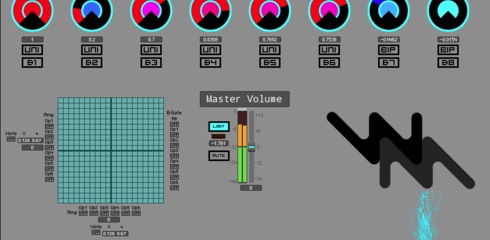Best of Reaktor User Library march 2.016
Effects
Maximizer
by Laurent Sevestre
Your best weapon if you're involved in the loundness war.
It's a mix of the Soundblaster limiter and the Sonnox Inflator.
***
MuRF GLP Series
by Mary Jean-Philippe
I wanted to recreate the famous Moog MIDIMurf with FM modulation filter through multiple modulation sources .
Panel A:
-Drive
-Mix
-Output
-Res X (Adjusts the resonance of all filters)
-ad (Sets the maximum value of the resonance knob)
-Tune (Adjust the "Pitch/CutOff" of all filters)
-L/M (Low Filters/Mid Filters)
-Vector (Multiply the "Pitch/CutOff" of all Filters)
-FM (Applies FM modulation on Cutoffs (selecting the source is located at the bottom right ))
-Gld (glide)
- Attack & release (For a trigger and a release of the filter , more or less reactive)
-Pattern (select bank of pattern)
-Morph (Morphing between 3 patterns)
-Faz rate & Amount (Apply LFO for all Cutoffs)
-Cutoffs Amps
-Touchpad "pos" (Defined the first time in the sequence)
-Touchpad "P-Shift" (Module cutoffs instantly)
Panel B:
Sequencer (YES!!!)
& More options for Drive & Seqs
***
Samplers
Beatrix
by david elson
Slicy sample mangler with a couple of extra mod sequencers thrown in
skin, additional processing and presets by Brett Lavallee
***
Bytechop Layersampler XT v1.2
by Byte Chop
This is the extended version of my Bytechop Layersampler v1.0
Features:
- 3band EQ for each voice
- gate sequencer
- 5 modulation sequencers with 3 destinations each
- NI Compressor
- NI Microverb
- Keyrange to build a split key setup with more instances of Layersampler
signal flow
voice 1 / 2 / 3 / 4
> Amp > Compressor > Reverb > Master
credits:
Compressor - NI Factory Macro
Reverb derivated from PRISM
thx to Herw, Salamanderanagram & the NI peepz
ChangeLog:
Update 1.2.0 03/2016
- sequencer issues fixed
Update 1.1.0 12/2014
- update download package
- set correct version number - 1.0
- audio demo added
- known bugs
- - when click into sequencers the first step will change
***
Goban Sounds Delay Processor
by Jim Hurley
This is a highly specialized, experimental noise generator.
It uses as a source, sets of sounds recorded from my Goban (Go Board) by striking it with Go stones in various ways.
The sounds may be played from a keyboard MIDI controller for pitches, via a manual Trigger (Mouse), or via an LFO to make repetitive noises.
A normal sampler or a granular sampler may be chosen to play the sample sounds.
The sound source then goes through one or two selectable delay stages with feedback. These are diffusion delays with quite a number of envelope controls over the various delay parameters.
It is a bit complicated to set up a sound, but a number of snapshots of different types should help you get started.
After the delays get processed, the sound is sent to a set of special effects that I made from 'Auralis Modded'.
The sound play is monophonic and the sound channels are mono up until the effects processing area.
Various people should be credited for some of the modules. There are a lot of NI Classic Library modules made by Eric Wiegand, some effects from Sean Costello, and a few other things - all should be commented internally.
Be careful - feedback is everywhere! So start with your speakers or headphones at low levels. There are some limiters and saturators to tame the worst cases, but ...
Version 2 - added MIDI control for LFO Pitch
Version 3 - more snapshots, no structural changes
Version 4 - added DC blocking filter in feedback path
Version 5 - normalized all snapshots + added Dietrich Pank's "auto-mute on snapshot change"
Version 6 - 128 snapshots in total
***
Synthesizers
bEAST 1.9
by Jörg Holzamer
VA Synth specialized in aggressive and distorted sounds
New in 1.9:
There are demo sounds for some of the new stuff. You can find them in the „demo of new features“ bank.
Overhaul of the „Supersaw Oscillator“. I found an interesting research paper from Alex Shore on the JP-8000 „Supersaw“, wich led to some modifications in my Supersaw Oscillator. It now consists of 7 Oscillators, (not 6 as before) and they come in three different flavors: „LoFi“ spares antialiasing and therefor has a rougher sound, „Super“ is built with primary oscillators (as before), and „Hyper“ adds another 7 oscillators on top, but these are impulse oscillators not sawtooths to add sheen to the top end. "Knack" key-triggers 3 Oscillators, the remaining 4 run free. This gives some impact to the attack.
Alternative envelopes with exponential attack
Most digital ADSR-Envelopes work with linear attack and exponential decay. Now you can switch the filter- and amp-envelope to exponential attack and control the attack slope. This removes some of the clockwork routine and feels a bit more "springy". I like it, what do you think?
Distortion
Inside the Beast structure there are 3 points where some kind of saturation or distortion is added and level is crucial to the sound: filter, amp and at the output. Filter and amp work polyphonicly, so there is no cross modulation between voices. But before the output-section is reached, all voices are added, so this distortion has quite a different effect. In the „Global“-Section to the left you now have access to „drive“ and „ceiling“ of this output distortion. Leave both knobs at zero to get the same sound as before. The „Drive Organ“ Snapshot is a good starting point for diving into distortion research. Besides the before mentioned parameters try „Filter Saturation“, „Volume“, „Sat Bias“ and „Highpass“. Each one has its specific impact on the overall sound.
***
JUNO-60 3.0
by Guido Weber
Version 3.0
Roland JUNO-60, containing all 112 factory patches.
Use your keyboards modulation wheel to modulate the VCF cutoff frequency.
Use keyboard aftertouch to trigger the LFO.
View B contains the rear side knobs and switches. The "Add On" section provides functions not available in the physical JUNO-60 keyboard.
***
Metaphysical Fabrications
by Christian Kjeldsen
52 new snapshots, 30 new samples, and new features by one of Metaphysical Function’s original sound designers.
New features include the ability to play the Resochord like a musical instrument via MIDI note input, providing faster and engaging control of each comb filter’s pitch; the ability to create chord progressions, with the Resochord via Metaphysical Function’s slider automation or via MIDI note input; Oscillator trim; Stereo input toggle; Sample vs Input crossfade
; Pitch bend and Mod Wheel control; and re-triggering of Sampler and Slider Automation via MIDI note input.
Metaphysical Function is one of the first professional sound design projects I worked on. After spending most of my career doing video game audio at Rockstar Games, it was really fun to come full circle and revisit my beginnings as a professional sound designer. I approached making these sounds from the perspective of pure sound design and letting my creative juices flow. I hope you enjoy the new sounds (and new features) as much as I’ve enjoyed creating them.
For an introduction to the sounds, new features, and insights into the sound design techniques what went into creating some of the sounds in Metaphysical Fabrications, check out these videos:
https://www.youtube.com/playlist?list=PLk7ZwfxQReIV7_MVZSxWGrmLZtQBQKSFR
www.contortDistort.com
***
SY66 V. 1.5
by Jonathan Leonard
Quick Start:
After opening SY66, please begin in the B view, Live page.
SY66 utilizes 8 live, or macro knobs that can be Unipolar(0-1) or Bipolar(-1-+1). These are virtual controls that can be assigned to nearly any parameter in the synthesizer and effects. To start out it is recommended that you connect a hardware controller with 8 knobs, or a Kore controller. In the B view LIVE page you will see 8 knobs. Midi learn or assign these 8 knobs to your hardware controller, then save SY66. As you load snapshots, your hardware knobs will now change function depending on how the snapshot was designed. The assigned functions are documented above the knobs and are intended for quick variations, performance and sound design. Additionally, most snapshots include assignments for the modwheel for instant tweaking.
Instrument designed, built and documented by Jonathan Adams Leonard and including work by Martijn Zwartjes, Stephan Schmitt, Max Zagler, and Eric Wiegand.
Requirements:
Reaktor version 6.0
Windows 7 and later or OSX Leopard
A mac or pc with an intel processor that is greater than 2 gHz
A controller with midi or USB (keyboard, drum pads...)
A basic knowledge of Reaktor conventions and terms.
Features:
6 Operators + External Input
7 Operator Types
Microtonal Scale functions
6x7 Audio Modulation Matrix for FM and RM
6 filter types per operator including Zero Delay Feedback (ZDF) versions
12 Multifunction Syncable LFO
12 ADSR Envelopes
6 Multistep Breakpoint Envelopes
15 Effect Types (8 distortions and shapers) in a 4 unit chain
Master Level Filter
Master Level Control with Brickwall Limiter and Soft Mute
Audio Trigger
Audio Envelope Follower
Pitch Tracker
Event Buss Mapper connecting 17 input types to 800+ modulation targets
Expression Shaper
129 Master and Operator Velocity Curves
XY Controller
***
